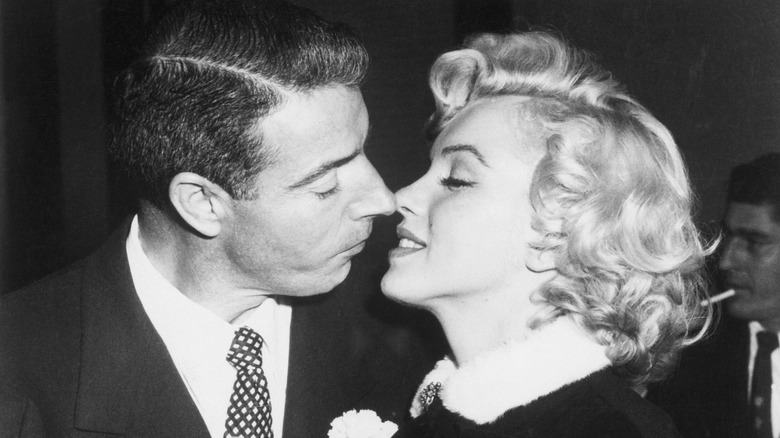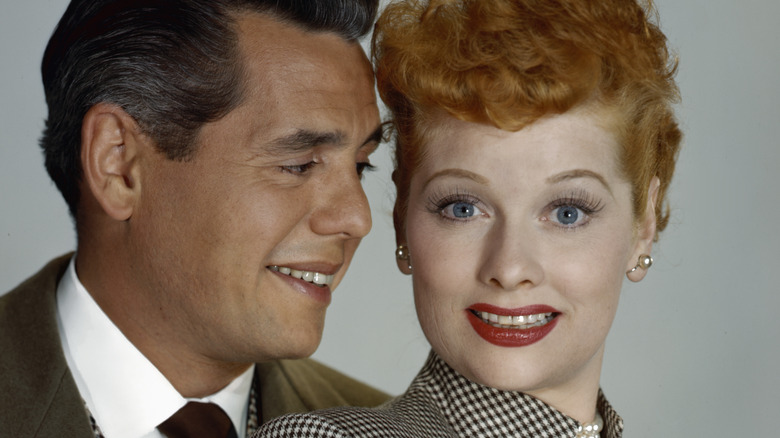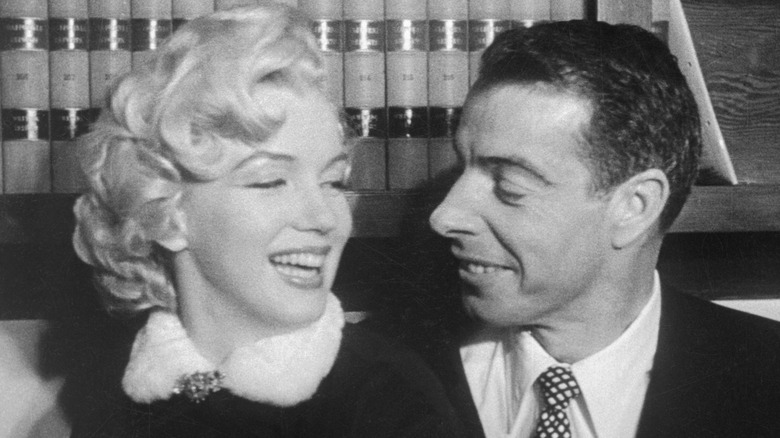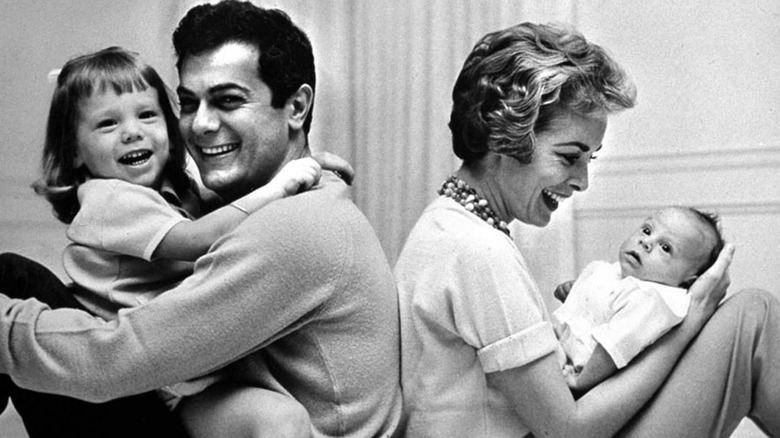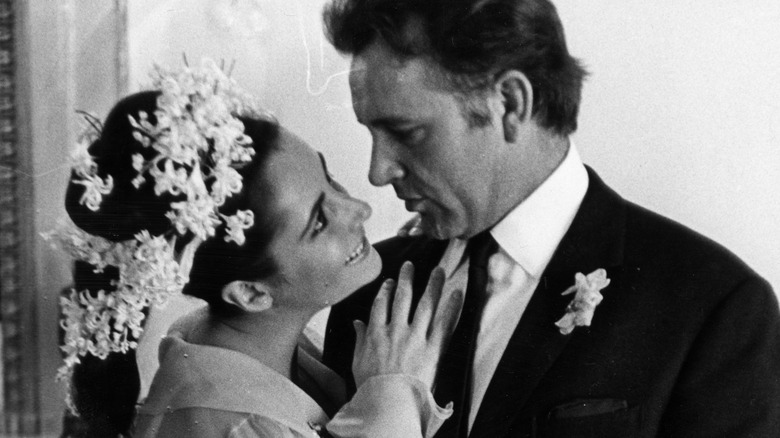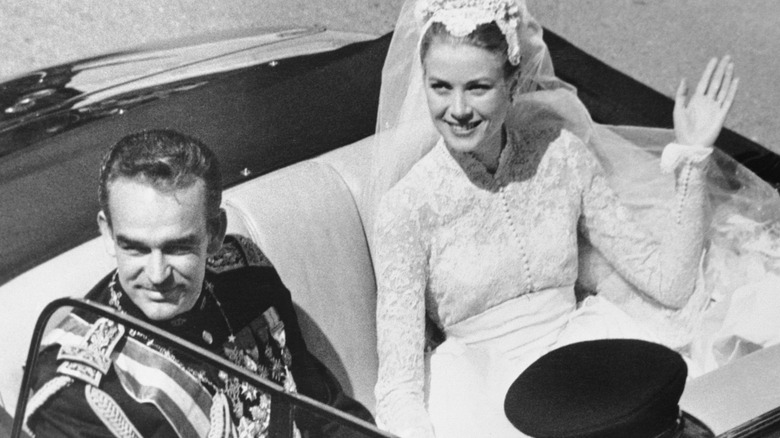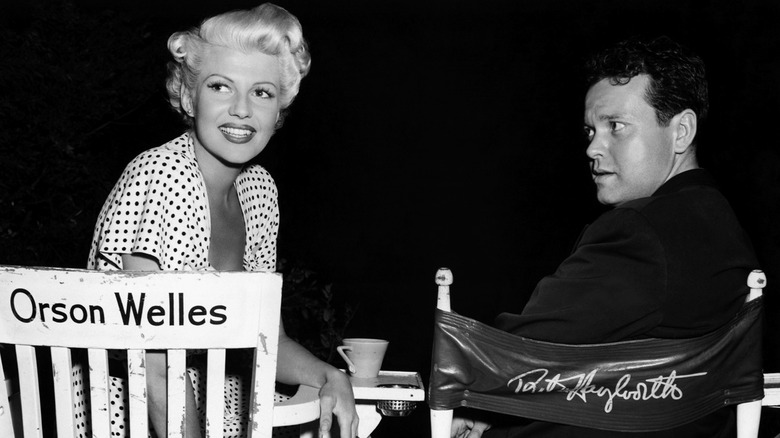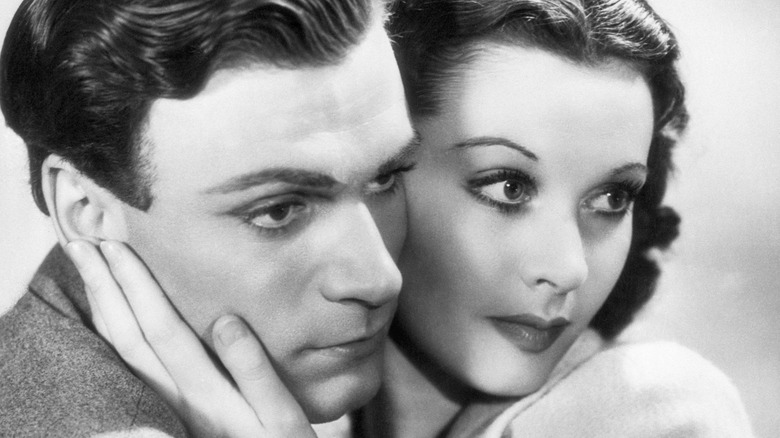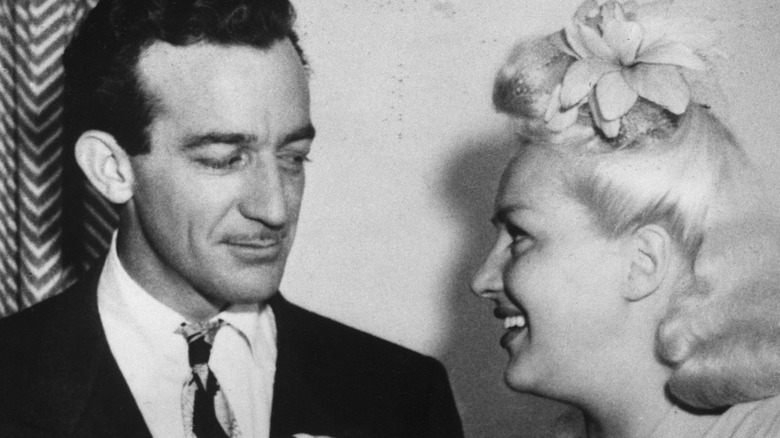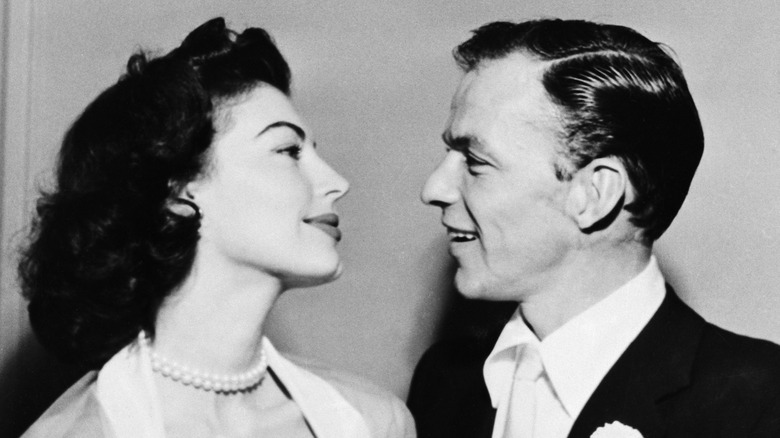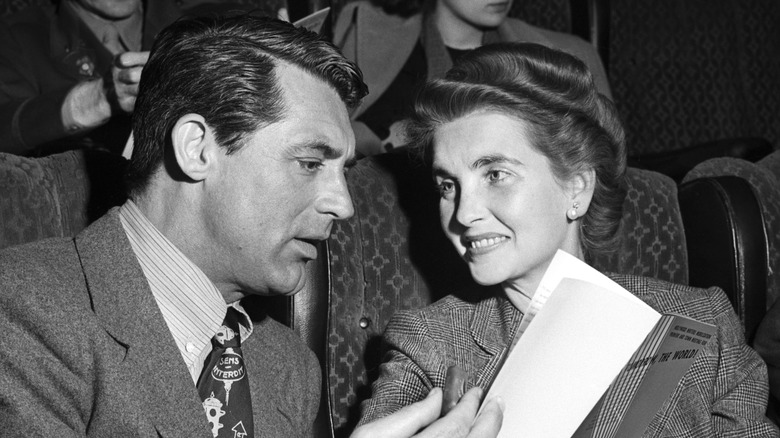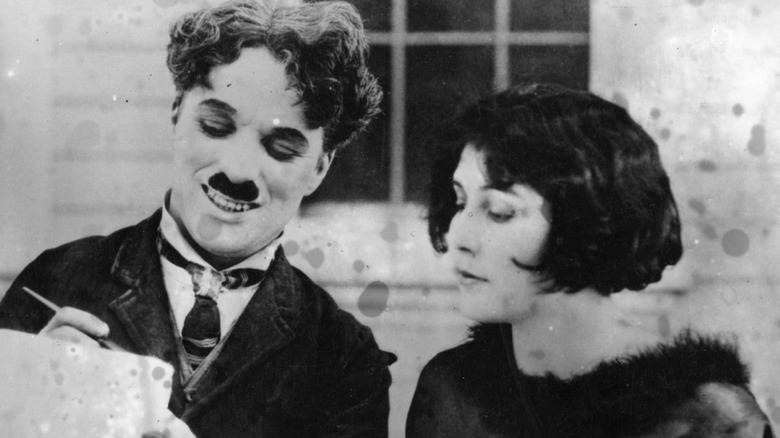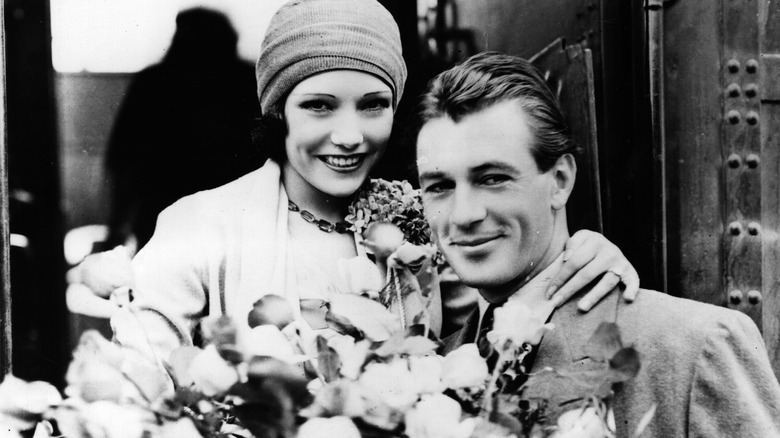Red-Flags That Signaled These Old Hollywood Romances Were Doomed
Old Hollywood is famous for its larger-than-life stars, and often the public was just as excited to hear details of their real-life whirlwind romances as they were to see them on the big screen. The sometimes lurid details of these relationships fueled an entire industry of Hollywood gossip columnists, who went to extreme lengths to find out the details of the personal lives of Golden Age film stars. In reality, not all of these Old Hollywood romances were as romantic as they seemed – but their fans were just as fascinated by the fighting and infidelity as they were by lavish weddings. The public delighted over Grace Kelly's fairytale transformation into a real-life princess and obsessed over Marilyn Monroe's wedding to Joe DiMaggio, but they were equally enthralled by the stories of violent fights between Elizabeth Taylor and Richard Burton.
Whether they were torn apart by circumstances, tainted by jealousy, or doomed from the start, these were the first signs that these classic Old Hollywood couples wouldn't last.
Lucille Ball and Desi Arnaz
Although the two were America's favorite couple on screen and off, the 20-year marriage of Lucille Ball and Desi Arnaz was a tempestuous one. Prior to "I Love Lucy," Arnaz had worked with veterans suffering from PTSD at Birmingham Hospital, and Ball frequently assisted him by raising money for better amenities for the patients and hiring young actresses to host bingo nights and dance with the patients. As described in Warren G. Harris's "Lucy & Desi," many of these young actresses that Ball sent to Arnaz ended up having affairs with him. Ball had several affairs of her own before asking for a divorce, but the two reconciled and went on to be married for more than another decade, working on "I Love Lucy" together.
Just before their 19th wedding anniversary in 1959, Arnaz's drinking brought their marriage back to the tipping point. In the midst of a fight at the studio, Arnaz asked for a divorce. At the time, Ball did not respond, but when Arnaz returned home to their Beverly Hills mansion, she was waiting for him. She was furious and screamed insults at him before appearing to pull a gun on him. She pulled the trigger – only to reveal that it was a joke cigarette lighter, a prop from "I Love Lucy." Arnaz lit his cigarette on it. That night, he left for good. Although the two remained close friends for the rest of their lives, the marriage was over.
Marilyn Monroe and Joe DiMaggio
Famed baseball player Joe DiMaggio and acting icon Marilyn Monroe were married in 1954, and the public could not get enough of their relationship. As soon as the honeymoon, cracks were beginning to form in the perfect, all-American love story. Monroe entertained the U.S. troops stationed in Korea before joining DiMaggio in Japan. She told her new husband all about the performance, concluding, "You never heard such cheering!" DiMaggio, a former star player for the New York Yankees, shot back: "Yes I have."
DiMaggio urged Monroe to retire and devote all of her time to their relationship. As quoted in Donald Spoto's biography, Monroe stated, "I didn't want to give up my career and that's what Joe wanted me to do most of all. He wanted me to be the beautiful ex-actress, just like he was the great former ballplayer."
Soon, Monroe was complaining to her friends that DiMaggio was possessive and resented her career. This undercurrent of resentment would come to a head during Monroe's most famous moment: the scene in "The Seven Year Itch" when she stands on a subway grate and her skirt billows up into the air. The image would become iconic, but DiMaggio, who was there to watch his wife act, was enraged. He stormed off the set, making his disapproval very obvious to Monroe and all of her coworkers. That night, the two argued in their hotel room. It is believed that the fight turned violent. Soon after, Monroe filed for divorce.
Tony Curtis and Janet Leigh
In 1951, Tony Curtis, star of films like "The Defiant Ones" and "Some Like It Hot," married one of Alfred Hitchcock's muses, the glamorous Janet Leigh. In Curtis' autobiography, he stated that MGM pressured Leigh to break up with him, but she refused every time. Despite this, from the very beginning of their relationship, Curtis feared that Leigh was not committed to their relationship.
The two first met at a cocktail party thrown by the studio making Leigh's current film "Jet Pilot." Curtis was immediately taken with her and asked for her number. Curtis was able to do an impression of beloved leading man Cary Grant, which he famously employed in "Some Like It Hot." As described in Michelangelo Capua's biography of Janet Leigh, Curtis called Leigh and pretended that he was Grant. This was a test to see if she would agree to go out with anyone else. Leigh wasn't fooled however, realized she was talking to Curtis, and turned "Grant" down.
Curtis would continue to grow more paranoid and jealous throughout their relationship. As recounted by a friend in Vanity Fair, when the two first got together, Curtis would frequently park his car across the street from Leigh's home, hoping to catch her with another man. After their divorce, Curtis would admit that he was very much in love with Leigh at the time, but didn't have any role models for a healthy marriage and wasn't sure how to behave.
Elizabeth Taylor and Richard Burton
Elizabeth Taylor and Richard Burton's whirlwind romance was famously riddled with ignored red flags. In Taylor's 1965 memoir (as quoted in Vanity Fair) she recalled being put off by first advances, when on the set of "Antony and Cleopatra" he reportedly asked her, "Has anyone ever told you that you're a very pretty girl?" For a beauty icon like Elizabeth Taylor, this was a clear backhanded compliment, intended to rankle her. Soon, however, Taylor was charmed by Burton's apparent vulnerable side when, due to a painful hangover, he got tripped up on his lines. When the two had their first onscreen kiss, they were unwilling to stop, even long after the director called "cut."
Their affair became a notorious thing, fueled by a mutual habit of risky drinking, wild spending, and increasingly brutal fights. The two both admitted to relishing their arguments, even as they became increasingly destructive and violent. On one occasion, Taylor hid in Burton's dressing room, and when she spotted one of his female co-stars coming in, leaped out and chased her away with a broken bottle. The two divorced in 1974, remarried in 1975, and swiftly divorced again. As quoted in Nancy Schoenberger and Sam Kasher's "Furious Love," Taylor would later say of the tumultuous relationship, "I don't want to be that much in love ever again."
Grace Kelly and Prince Rainier
In 1955, Grace Kelly was one of the biggest stars in the world. When she was engaged to Prince Rainier III of Monaco, the public became obsessed with the upcoming wedding where beloved Hollywood royalty would become an actual princess. The ceremony was massive and elaborate, but the marriage was anything but perfect. Even before the wedding, there were signs that their union wasn't based on the fairytale true love that her fans hoped for.
The royal family of Monaco insisted Kelly buy her way into their monarchy. It was expected that her father, a multimillionaire, would pay a massive sum so that his daughter could join the nobility. As described in Robert Lacey's book "Grace," Kelly's father was appalled at the suggestion, feeling that his tremendously successful and beautiful daughter was doing Rainier a favor by marrying him, not the other way around. This wasn't the only alarming condition that Kelly had to agree to in order to become Princess of Monaco. Most distressing to her friends was any children that the couple had would automatically be custody of Rainier were they to divorce. After the marriage, Kelly was forced to give up her American citizenship, her films were banned in her new country, and she was expected to leave acting behind forever. While the couple never divorced, their marriage was a failure.
Orson Welles and Rita Hayworth
In 1943, "Citizen Kane" auteur Orson Welles and glamorous leading lady Rita Hayworth might have been expected to have an enormous wedding befitting Hollywood royalty, but instead, the two met during Hayworth's lunch break for a courthouse wedding. Immediately afterward, the happy couple returned to work. This spontaneous and romantic event surprised the press and their fans alike, but the marriage wouldn't last. The two divorced in 1947.
As described in Barbara Leaming's biography of Orson Welles, the director was committed to their marriage, but Hayworth still suspected him of being unfaithful. Often, he would return home to find her sobbing and furious with him for imagined infidelities. Her insecurity and jealousy had come from previous relationships, and she was unable to trust him, which took a toll on the marriage and drove a wedge between them.
Overwhelmed, Welles pulled away – and then genuinely did begin having an affair with Judy Garland. On one occasion, he had purchased a massive amount of flowers for Garland but then had forgotten to give them to her, so when he returned home to Hayworth, his car was full of flowers intended for another woman. A crisis was only avoided because Welles' secretary had the foresight to throw away the card that had come with the flowers, and Hayworth was delighted with the gesture.
Vivien Leigh and Laurence Olivier
Laurence Olivier, often called the greatest actor of the 20th century, and Vivien Leigh of "Gone with the Wind" and "A Streetcar Named Desire" had a 30-year relationship that was famously turbulent. Leigh was suffering from what was then called "manic depressive disorder" which was particularly difficult to manage with the kind of treatment that was available in the 1940s. As described in Stephen Galloway's "Truly Madly" (via The Guardian) Leigh was given electroshock therapy, and was even advised by a friend to try an exorcism, but was unable to find real help. Olivier did not know how to help her or even how to be sensitive to what she was going through. Upon hearing about Leigh's accidental overdose while attempting to manage her condition, Olivier sent her a letter suggesting that he erotically spank her for her mistake.
As her mental health worsened, the couple began having more fights, some of which were physically violent. On one occasion, a fight in their home culminated in Olivier physically throwing Leigh towards the bed, but she hit the marble bedside table instead, leaving her with a painful cut. From that moment forward, Olivier stated that he feared he or Leigh might one day kill the other. In 1960, the two divorced. As quoted by The Guardian, later Olivier wrote to Leigh, "You did nobly and bravely and beautifully and I am very oh so sorry, very sorry, that it must have been much hell for you."
If you or someone you know is dealing with domestic abuse, you can call the National Domestic Violence Hotline at 1−800−799−7233. You can also find more information, resources, and support at their website.
Betty Grable and Harry James
Pin-up girl turned beloved 1940s film star Betty Grable had a secret relationship with jazz icon Harry James – until it became suddenly public when he got into a physical fight with her ex-boyfriend, who had been using his mob ties to attempt to intimidate them. Once the two were married, Grable was ready to transform from the most beautiful woman in Hollywood into a perfect housewife. As it turned out, that wasn't a transformation James wanted his wife to make.
As described in Peter Levinson's "Trumpet Blues," when Grable had her first child, she planned on quitting her lucrative career in Hollywood. She adored being a mother and was beginning to feel that family, not her career should be her priority. James was unwilling to give up their Hollywood lifestyle. He told Grable, "If you quit the movies, you can say goodbye to all this. I don't make nearly enough to keep us in this style."
Their marriage, which would go on to be characterized by risky drinking and affairs, would not last. The two divorced in 1965.
Frank Sinatra and Ava Gardner
Film star Ava Gardner was not one to be pushed into a relationship she didn't want to be in. Famously, she rebuffed the advances of Howard Hughes by smacking him in the head with a candlestick, knocking him unconscious. When she met legendary crooner Frank Sinatra, she was at the height of her fame while he was both married and far past the peak of his career, but she would consider him the great love of her life. Their own marriage would soon be marred by Sinatra's intense jealousy and instability, but before their wedding, Gardner received many, many threats and insults from the public for sparking the end of Sinatra's previous marriage. In November of 1951, the night before the wedding, Gardner would receive an even more unsettling letter.
As recounted by Lee Server in his biography of Garder, while guests were gathering for the wedding, a letter was delivered to the hotel for Gardner. It was from a woman who claimed to be having an affair with Sinatra. The details were highly specific, including his behavior in bed and physical traits a stranger could not have known. Though she suspected Howard Hughes had orchestrated having Sinatra's mistress send the letter to break up the new couple, Gardner knew that the woman's claims were true and that Sinatra had been unfaithful. She almost called off the wedding, but in the end, chose to go through with it anyway.
Cary Grant and Barbara Hutton
Heiress Barbara Hutton, who famously had her lavish 18th birthday party at the height of the Great Depression, was one of the most despised figures in the media. Leading man Cary Grant was one of the most beloved stars in Hollywood. In 1942, the two were married.
As described in "Million Dollar Baby" by Philip Rensselaer, Hutton had an idealized vision of Hollywood's favorite leading man, and she hoped that being with Grant would solve all of her problems. At the beginning of their marriage, Hutton worked hard to overcome previous destructive patterns in her life, win back the American public through charity, and leave her controversial past behind her. After a year, however, Hutton began throwing wild parties and kept the house alive with guests at all hours. Grant was a famous homebody who preferred a quiet night in. Their differences put a tremendous amount of pressure on the relationship. They separated several times, but their friends knew how much they cared for each other and always tried to get them back together. On one occasion, their friends had invited them to stay at their home to relax and reconcile – only to come into their room early one morning and find Hutton asleep in the bed and Grant sleeping in the bathtub. Their marriage was over.
Despite the way things ended, Hutton would always consider Grant the best of her seven husbands and the great love of her life.
Charlie Chaplin and Lita Grey
The following section describes an inappropriate relationship between an adult and a minor.
Charlie Chaplin's personal relationships however have long been the subject of criticism, and the most controversial was his marriage to Lita Grey.
At the age of 12, young Lita Grey was formally introduced to Charlie Chaplin by a mutual friend. The director was in his early 30s, and looking to cast performers for "The Kid." Grey would be cast as an angel. The exact timeline of their relationship is unknown, but in 1925, when Grey was 15, she became pregnant. Chaplin was the father. In Grey's book "My Life with Chaplin," she recounts how anxious she and her mother had been to tell her grandfather, William Curry, but he wasn't angry with Lita. Instead, he resolved to kill Chaplin for what he had done to his granddaughter. If he had not been physically restrained by his wife and daughter, he might have. Ultimately, it was Lita's uncle who spoke to Chaplin, and informed him that if he didn't marry Grey, he would have him arrested. Neither wanted the marriage, least of all Chaplin (who offered Grey and her family a large sum of money and to find her a more appropriately aged man to marry her.) Ultimately, they were married, but considering its horrific beginnings, there was no way for the relationship to work. Chaplin himself referred to the marriage as "hopeless."
If you or someone you know may be the victim of child abuse, please contact the Childhelp National Child Abuse Hotline at 1-800-4-A-Child (1-800-422-4453) or contact their live chat services.
Lupe Vélez and Gary Cooper
Lupe Vélez was known for playing sexy, wild, chaotic characters in Hollywood throughout the late 1920s and 30s. In real life, she could be even more unpredictable. Surprisingly, her most famous romantic relationship in Hollywood was with calm, quiet leading man Gary Cooper. For three years, Cooper found her irresistible, but her violent temper became dangerous.
The fact that he tried to stay calm when she lost control only made her more furious. As described in Conner Floyd's book "Lupe Vélez and her Lovers," on one occasion, Cooper arrived at the studio bruised and with deep scratches on his face. He confessed to a friend that it was Vélez who had attacked him, and that he had slapped her back – something he felt tremendously guilty about. As time went on, the violence escalated. Vélez carried a knife with her for protection, and on several occasions would unexpectedly attack Cooper with it. Once, while he was cooking, she attacked him suddenly, stabbing him in the arm – a feat she seemed to be proud of. After their breakup in 1931, Vélez shot at Cooper as he tried to get onto a train.
If you or someone you know is dealing with domestic abuse, you can call the National Domestic Violence Hotline at 1−800−799−7233. You can also find more information, resources, and support at their website.
